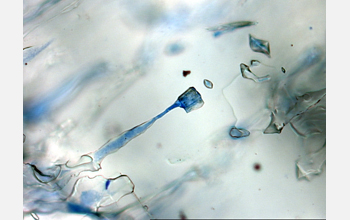Multimedia Gallery
Gel-like Mucus From Algae in Ice Pore (Image 2)
Gel-like mucus (stained blue) covers individual sea-ice algae clustered in a tiny, box-shaped pore in the ice and fills the channel from the pore to the ocean. Researchers have found that this same gel-like mucus (secreted by the algae as a kind of antifreeze (against temperatures well below minus 10 Celsius) is also allowing them to sculpt microscopic channels and pores in the ice that are hospitable to themselves as well as other microorganisms. The mucus depresses the freezing point and keeps pore spaces in ice filled with at least some liquid so the algae don't freeze and die.
This ability to mold the ice to their benefit should help sea-ice algae adapt to a warming world.
However, researchers question whether the ice will be weakened by the introduction of more channels and pores, although the openings plugged with algal secretions actually hold more salty water and thus may slow melting in the spring and summer.
This research was supported by grants from the National Science Foundation (OPP 00-85457, OPP 02-21055, and OPP 04-54955). To learn more, see the University of Washington news release Algal Antifreeze Makes Inroads Into Ice. (Date of Image: February 2002) [See related image Here.]
SORRY: THIS IMAGE IS NOT AVAILABLE IN HIGH RESOLUTION FORMAT
Credit: Christopher Krembs, Department of Ecology, Washington State University
Images and other media in the National Science Foundation Multimedia Gallery are available for use in print and electronic material by NSF employees, members of the media, university staff, teachers and the general public. All media in the gallery are intended for personal, educational and nonprofit/non-commercial use only.
Images credited to the National Science Foundation, a federal agency, are in the public domain. The images were created by employees of the United States Government as part of their official duties or prepared by contractors as "works for hire" for NSF. You may freely use NSF-credited images and, at your discretion, credit NSF with a "Courtesy: National Science Foundation" notation.
Additional information about general usage can be found in Conditions.
Also Available:
Download the high-resolution JPG version of the image. (308 KB)
Use your mouse to right-click (Mac users may need to Ctrl-click) the link above and choose the option that will save the file or target to your computer.



